LEXUS RC F 2015 Owners Manual
Manufacturer: LEXUS, Model Year: 2015, Model line: RC F, Model: LEXUS RC F 2015Pages: 684, PDF Size: 9.31 MB
Page 581 of 684
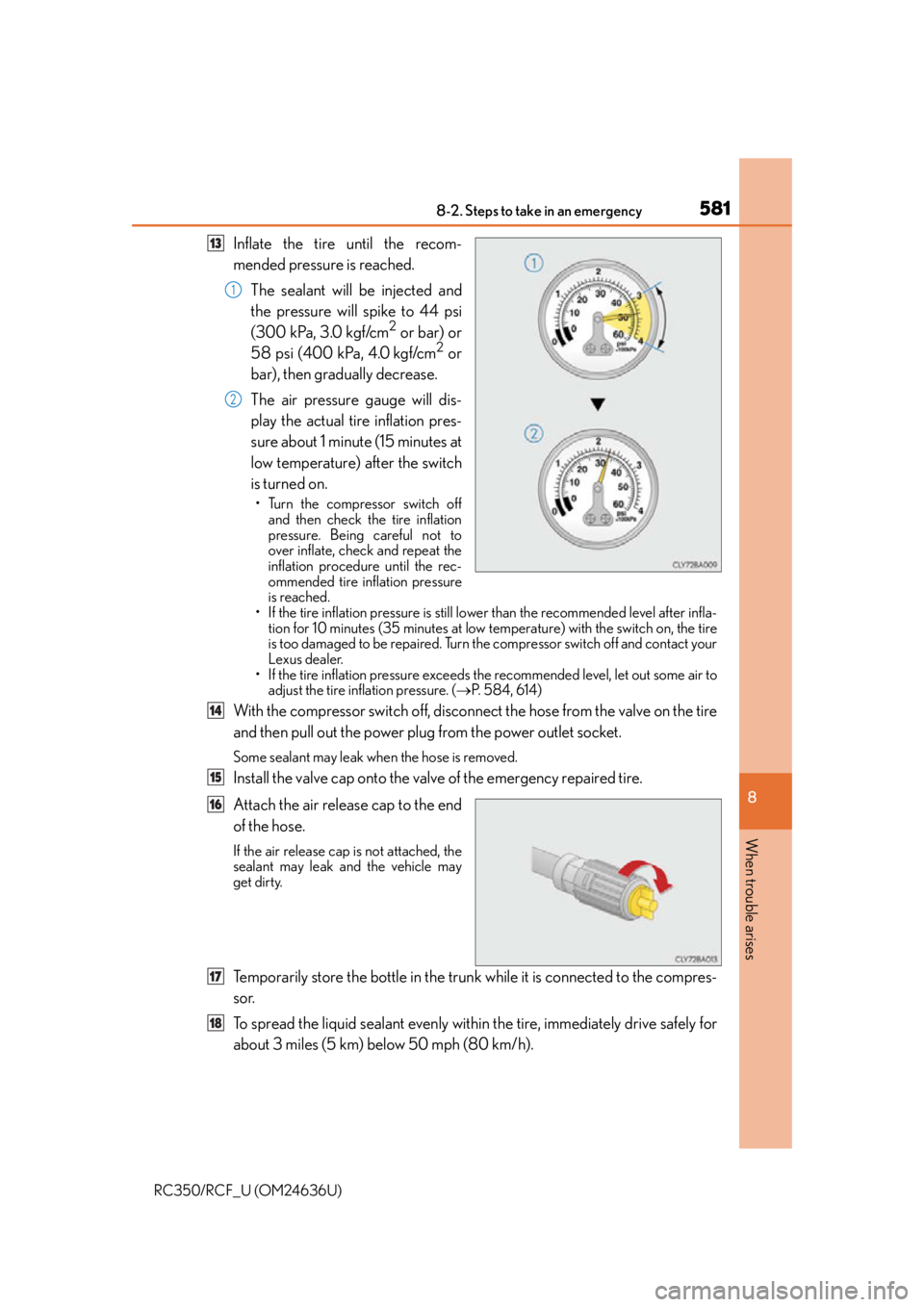
5818-2. Steps to take in an emergency
8
When trouble arises
RC350/RCF_U (OM24636U)
Inflate the tire until the recom-
mended pressure is reached.The sealant will be injected and
the pressure will spike to 44 psi
(300 kPa, 3.0 kgf/cm
2 or bar) or
58 psi (400 kPa, 4.0 kgf/cm2 or
bar), then gradually decrease.
The air pressure gauge will dis-
play the actual tire inflation pres-
sure about 1 minute (15 minutes at
low temperature) after the switch
is turned on.
• Turn the compressor switch off and then check the tire inflation
pressure. Being careful not to
over inflate, check and repeat the
inflation procedure until the rec-
ommended tire inflation pressure
is reached.
• If the tire inflation pressure is still lo wer than the recommended level after infla-
tion for 10 minutes (35 minutes at low temperature) with the switch on, the tire
is too damaged to be repaired. Turn th e compressor switch off and contact your
Lexus dealer.
• If the tire inflation pressure exceeds the recommended level, let out some air to
adjust the tire inflation pressure. ( P. 584, 614)
With the compressor switch off, disconnect the hose from the valve on the tire
and then pull out the power plug from the power outlet socket.
Some sealant may leak when the hose is removed.
Install the valve cap onto the valve of the emergency repaired tire.
Attach the air release cap to the end
of the hose.
If the air release cap is not attached, the
sealant may leak and the vehicle may
get dirty.
Temporarily store the bottle in the trun k while it is connected to the compres-
sor.
To spread the liquid sealant evenly within the tire, immediately drive safely for
about 3 miles (5 km) below 50 mph (80 km/h).
13
1
2
14
15
16
17
18
Page 582 of 684
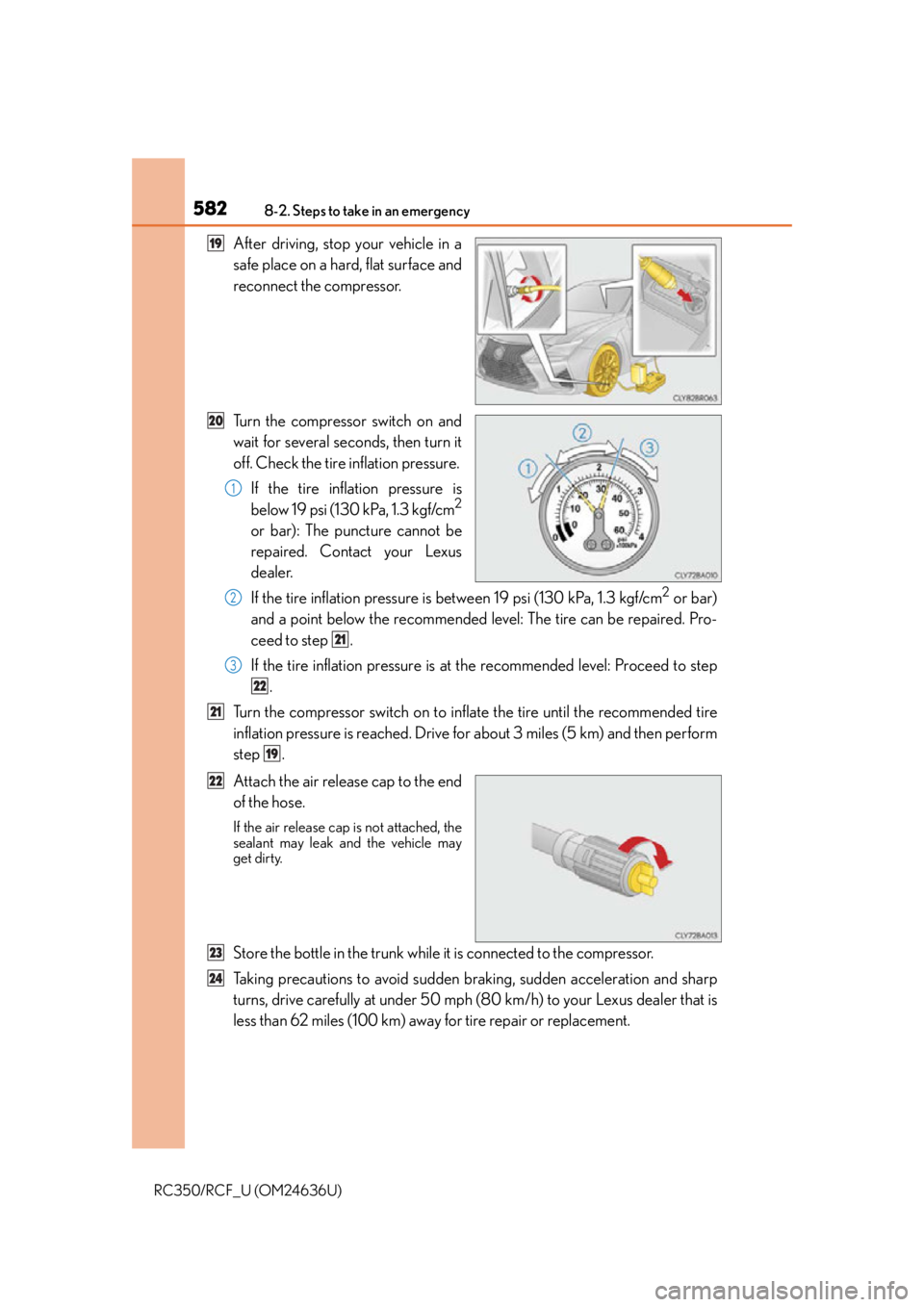
5828-2. Steps to take in an emergency
RC350/RCF_U (OM24636U)
After driving, stop your vehicle in a
safe place on a hard, flat surface and
reconnect the compressor.
Turn the compressor switch on and
wait for several seconds, then turn it
off. Check the tire inflation pressure.If the tire inflation pressure is
below 19 psi (130 kPa, 1.3 kgf/cm
2
or bar): The puncture cannot be
repaired. Contact your Lexus
dealer.
If the tire inflation pressure is between 19 psi (130 kPa, 1.3 kgf/cm
2 or bar)
and a point below the recommended level: The tire can be repaired. Pro-
ceed to step .
If the tire inflation pressure is at the recommended level: Proceed to step .
Turn the compressor switch on to infl ate the tire until the recommended tire
inflation pressure is reached. Drive for about 3 miles (5 km) and then perform
step .
Attach the air release cap to the end
of the hose.
If the air release cap is not attached, the
sealant may leak and the vehicle may
get dirty.
Store the bottle in the trunk while it is connected to the compressor.
Taking precautions to avoid sudden br aking, sudden acceleration and sharp
turns, drive carefully at under 50 mph (80 km/h) to your Lexus dealer that is
less than 62 miles (100 km) away for tire repair or replacement.
19
20
1
2
21
3
1322
21
19
22
23
24
Page 583 of 684

5838-2. Steps to take in an emergency
8
When trouble arises
RC350/RCF_U (OM24636U)
■In the following cases, the tire cannot be repaired with the emergency tire puncture
repair kit. Contact your Lexus dealer.
●When the tire is damaged due to driving without sufficient air pressure
●When the tire lost air pressure due to a crack or damage in the tire sidewall
●When the tire is visibly separated from the wheel
●When the cut or damage to the trea d is 0.16 in. (4 mm) long or more
●When the wheel is damaged
●When 2 or more sharp objects, such as nails or screws, have passed through the tread
on a single tire
●When there is more than one hole or cut in the damaged tire
●When the sealant has expired
■Emergency tire puncture repair kit
●The sealant has a limited lifespan. The expiry date is marked on the bottle. The sealant
should be replaced before the expiry date. Contact your Lexus dealer for replacement.
●The sealant stored in the emergency tire puncture repair kit can be used only once to
temporarily repair a single tire. If the seal ant has been used and needs to be purchased,
contact your Lexus dealer. The compressor is reusable.
●The sealant can be used when the outside temperature is from -40 F (-40 C) to
140 F (60 C).
●The kit is exclusively designed for size and type of tires originally installed on your vehi-
cle. Do not use it for tires that a different size than the original ones, or for any other
purposes.
●If the sealant gets on your clothes, it may stain.
●If the sealant adheres to a wheel or the surface of the vehicle body, the stain may not be
removable if it is not cleaned at once. Immediately wipe away the sealant with a wet
cloth.
●During operation of the kit, a loud operation noise is produced. This does not indicate a
malfunction.
●Do not use the emergency tire puncture repair kit to check or to adjust the tire pres-
sure.
Page 584 of 684
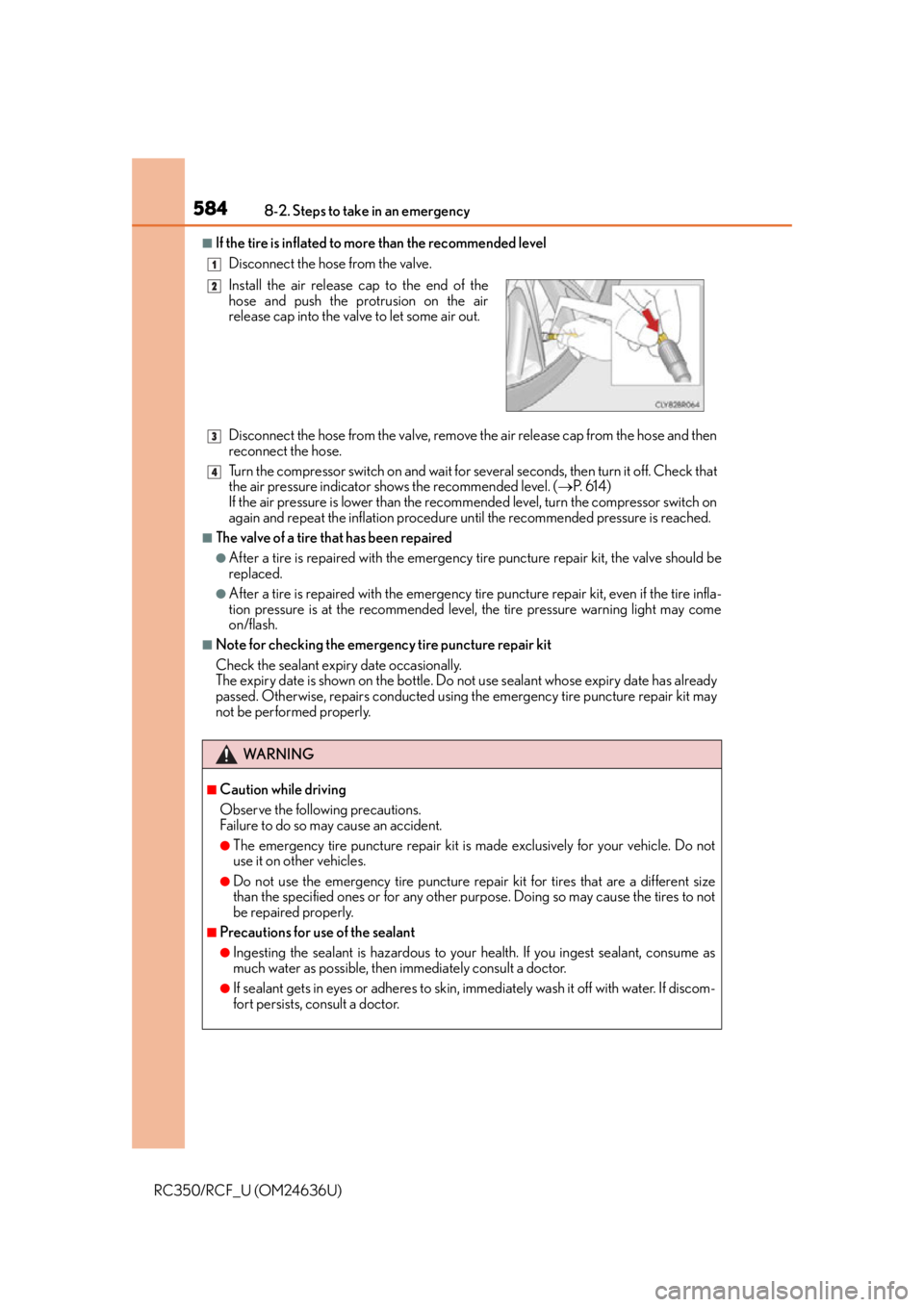
5848-2. Steps to take in an emergency
RC350/RCF_U (OM24636U)
■If the tire is inflated to more than the recommended levelDisconnect the hose from the valve.
Disconnect the hose from the valve, remove the air release cap from the hose and then
reconnect the hose.
Turn the compressor switch on and wait for se veral seconds, then turn it off. Check that
the air pressure indicator shows the recommended level. ( P. 6 1 4 )
If the air pressure is lower than the recommended level, turn the compressor switch on
again and repeat the inflation procedure until the recommended pressure is reached.
■The valve of a tire that has been repaired
●After a tire is repaired with the emergency tire puncture repair kit, the valve should be
replaced.
●After a tire is repaired with the emergency tire puncture repair kit, even if the tire infla-
tion pressure is at the recommended level, the tire pressure warning light may come
on/flash.
■Note for checking the emergency tire puncture repair kit
Check the sealant expiry date occasionally.
The expiry date is shown on the bottle. Do not use sealant whose expiry date has already
passed. Otherwise, repairs conducted using th e emergency tire puncture repair kit may
not be performed properly. Install the air release cap to the end of the
hose and push the protrusion on the air
release cap into the valve to let some air out.
WA R N I N G
■Caution while driving
Observe the following precautions.
Failure to do so may cause an accident.
●The emergency tire puncture repair kit is made exclusively for your vehicle. Do not
use it on other vehicles.
●Do not use the emergency tire puncture repair kit for tires that are a different size
than the specified ones or fo
r any other purpose. Doing so may cause the tires to not
be repaired properly.
■Precautions for use of the sealant
●Ingesting the sealant is hazardous to your health. If you ingest sealant, consume as
much water as possible, then immediately consult a doctor.
●If sealant gets in eyes or adheres to skin, immediately wash it off with water. If discom-
fort persists, consult a doctor.
1
2
3
4
Page 585 of 684

5858-2. Steps to take in an emergency
8
When trouble arises
RC350/RCF_U (OM24636U)
WA R N I N G
■When fixing the flat tire
●Stop your vehicle in a safe and flat area.
●Do not touch the wheels or the area around the brakes immediately after the vehicle
has been driven.
After the vehicle has been driven, the wheels and the area around the brakes may be
extremely hot. Touching these areas with hands, feet or other body parts may result in
burns.
●Connect the valve and hose securely wi th the tire installed on the vehicle.
●If the hose is not properly connected to the valve, air leakage may occur or sealant
may be sprayed out.
●If the hose comes off the valve while inflating the tire, there is a risk that the hose will
move abruptly due to air pressure.
●After inflation of the tire has completed, the sealant may splatter when the hose is dis-
connected or some air is let out of the tire.
●Follow the operation procedure to repair the tire. If the procedure is not followed, the
sealant may spray out.
●Keep back from the tire while it is being re paired, as there is a chance of it bursting
while the repair operation is being perfor med. If you notice any cracks or deforma-
tion of the tire, turn off the compressor sw itch and stop the repair operation immedi-
ately.
●The kit may overheat if operated for a long period of time. Do not operate the com-
pressor continuously for more than 35 minutes.
●Parts of the kit become hot during operatio n. Be careful handling the kit during and
after operation. Do not touch the metal part around the connecting area between the
bottle and compressor. It will be extremely hot.
●Do not attach the vehicle speed warning sticker to an area other than the one indi-
cated. If the sticker is attached to an area where an SRS airbag is located, such as the
pad of the steering wheel, it may prevent the SRS airbag from operating properly.
■Driving to spread the liquid sealant evenly
●Drive the vehicle carefully at a low speed. Be especially careful when turning and cor-
nering.
●If the vehicle does not drive straight or you feel a pull through the steering wheel, stop
the vehicle and check the following:
• Tire condition. The tire may have separated from the wheel.
• Tire inflation pressure. If tire inflation pressure is 19 psi (130 kPa, 1.3 kgf/cm
2 or
bar) or below, this may indicate severe tire damage.
Page 586 of 684

5868-2. Steps to take in an emergency
RC350/RCF_U (OM24636U)
NOTICE
■When performing an emergency repair
●Perform the emergency repair without removing the nail or screw that has punctured
the tread of the tire. If the object that has punctured the tire is removed, repair by the
emergency tire puncture repair kit may not be possible.
●The kit is not waterproof. Make sure that th e kit is not exposed to water, such as when
it is being used in the rain.
●Do not put the kit directly onto dusty ground such as sand at the side of the road. If the
kit vacuums up dust etc., a malfunction may occur.
●Make sure to stand the kit with the bottle ve rtical. The kit cannot work properly if it is
laid on its side.
■Handling the emergency tire puncture repair kit
●The compressor power source should be 12 V DC suitable for vehicle use. Do not
connect the compressor to any other source.
●If gasoline splatters on the kit, the kit may deteriorate. Take care not to allow gasoline
to contact it.
●Store the emergency tire puncture repair kit in the trunk.
The kit may be thrown around during sudden braking and so forth, damaging the kit.
●Store the kit in its assigned place out of reach of children.
●Do not disassemble or modify the kit. Do not subject parts such as the air pressure
indicator to impacts. This may cause a malfunction.
■To avoid damage to the tire pressu re warning valves and transmitters
When a tire is repaired with liquid sealants, the tire pressure warning valve and trans-
mitter may not operate properly. If a liquid se alant is used, contact your Lexus dealer as
soon as possible. Make sure to replace the tire pressure warning valve and transmitter
when replacing the tire. ( P. 4 9 2 )
Page 587 of 684
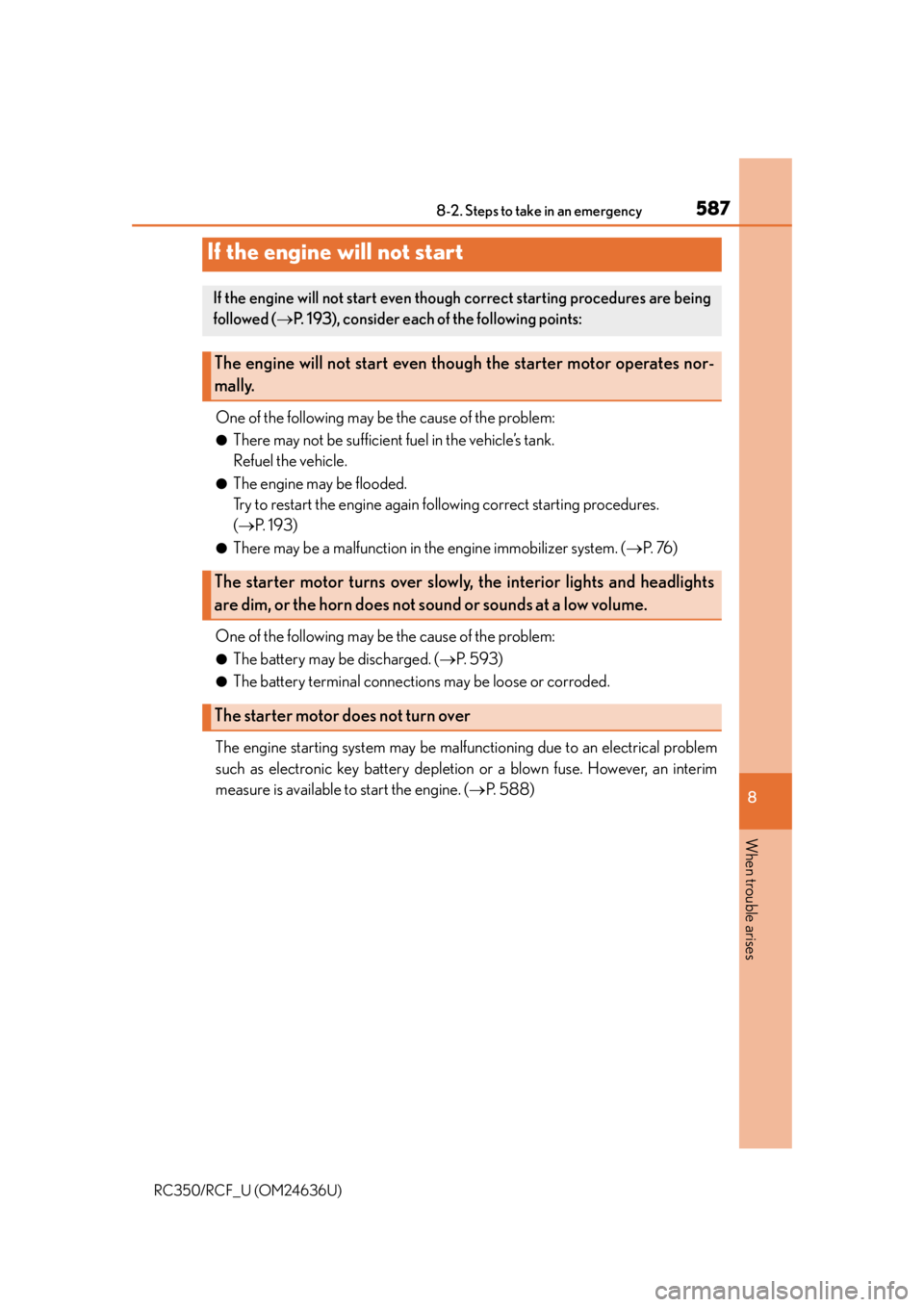
5878-2. Steps to take in an emergency
8
When trouble arises
RC350/RCF_U (OM24636U)
One of the following may be the cause of the problem:
●There may not be sufficient fuel in the vehicle’s tank.
Refuel the vehicle.
●The engine may be flooded.
Try to restart the engine again following correct starting procedures.
(P. 1 9 3 )
●There may be a malfunction in the engine immobilizer system. ( P. 76 )
One of the following may be the cause of the problem:
●The battery may be discharged. ( P. 5 9 3 )
●The battery terminal connections may be loose or corroded.
The engine starting system may be malfun ctioning due to an electrical problem
such as electronic key battery depletion or a blown fuse. However, an interim
measure is available to start the engine. ( P. 588)
If the engine will not start
If the engine will not start even though correct starting procedures are being
followed ( P. 193), consider each of the following points:
The engine will not start even thoug h the starter motor operates nor-
mally.
The starter motor turns over slowly , the interior lights and headlights
are dim, or the horn does not sound or sounds at a low volume.
The starter motor does not turn over
Page 588 of 684
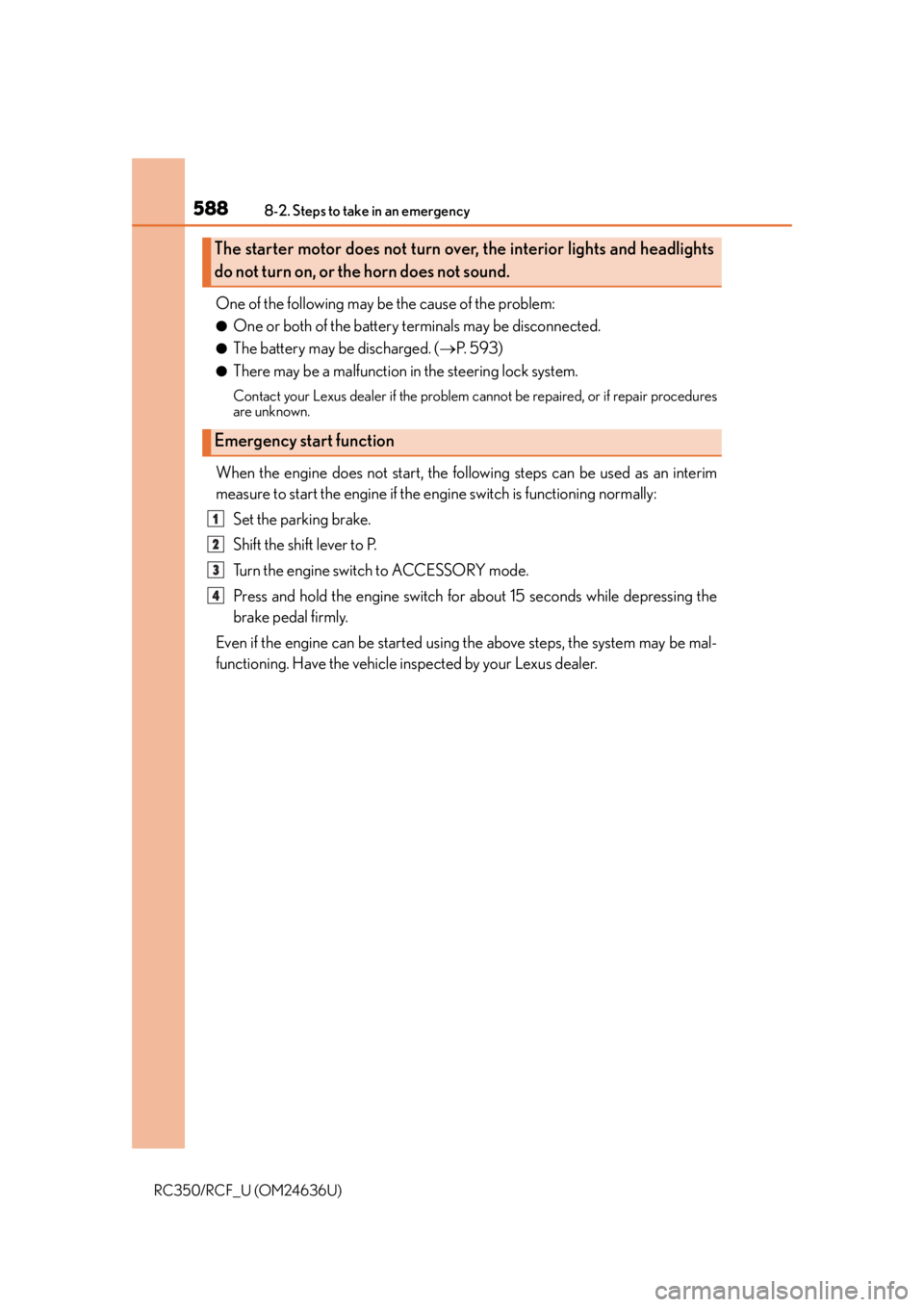
5888-2. Steps to take in an emergency
RC350/RCF_U (OM24636U)
One of the following may be the cause of the problem:
●One or both of the battery terminals may be disconnected.
●The battery may be discharged. (P. 5 9 3 )
●There may be a malfunction in the steering lock system.
Contact your Lexus dealer if the problem cannot be repaired, or if repair procedures
are unknown.
When the engine does not start, the following steps can be used as an interim
measure to start the engine if the engine switch is functioning normally:
Set the parking brake.
Shift the shift lever to P.
Turn the engine switch to ACCESSORY mode.
Press and hold the engine switch for about 15 seconds while depressing the
brake pedal firmly.
Even if the engine can be started using the above steps, the system may be mal-
functioning. Have the vehicle inspected by your Lexus dealer.
The starter motor does not turn over, the interior lights and headlights
do not turn on, or the horn does not sound.
Emergency start function
1
2
3
4
Page 589 of 684
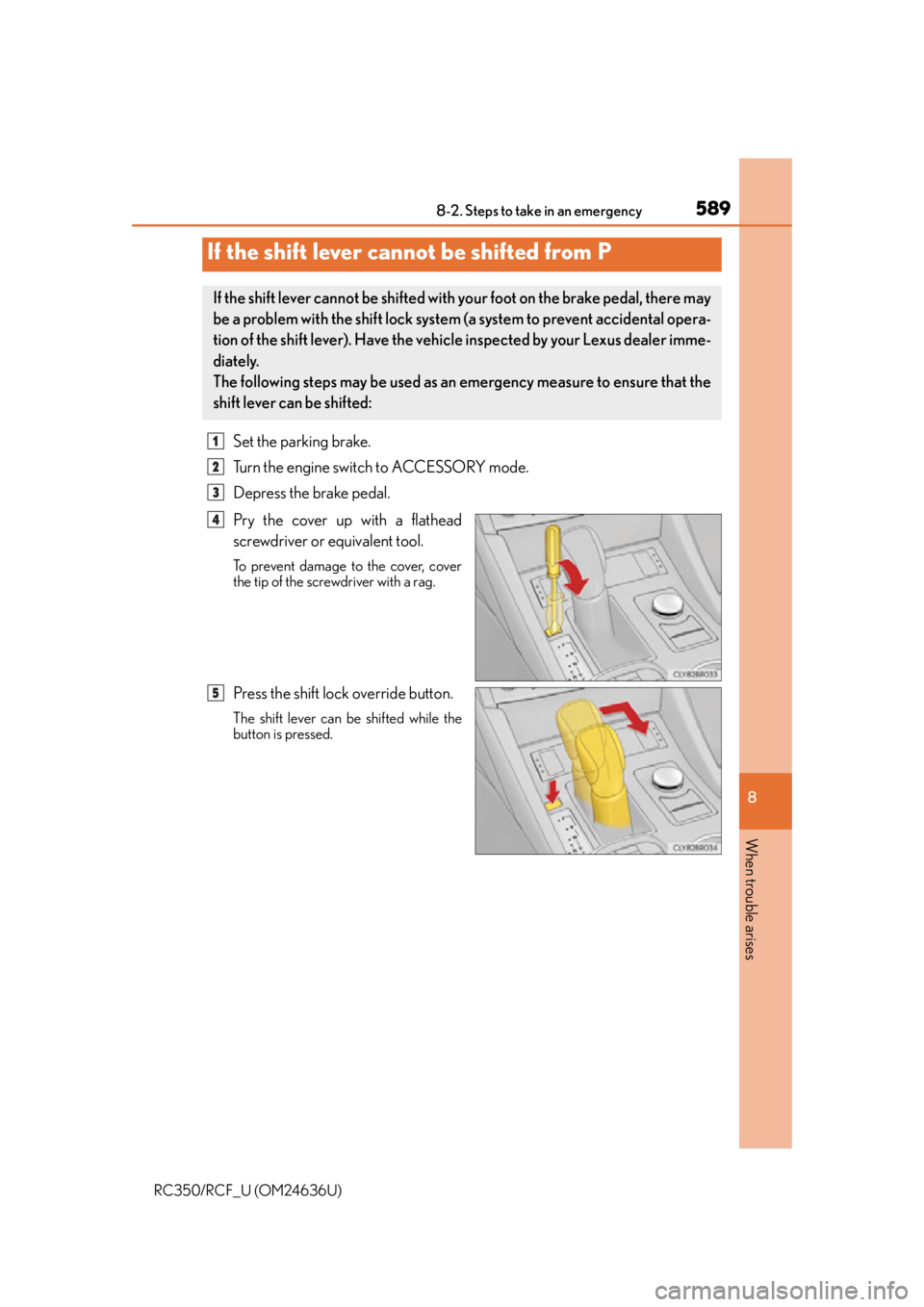
5898-2. Steps to take in an emergency
8
When trouble arises
RC350/RCF_U (OM24636U)
Set the parking brake.
Turn the engine switch to ACCESSORY mode.
Depress the brake pedal.
Pry the cover up with a flathead
screwdriver or equivalent tool.
To prevent damage to the cover, cover
the tip of the screwdriver with a rag.
Press the shift lock override button.
The shift lever can be shifted while the
button is pressed.
If the shift lever cannot be shifted from P
If the shift lever cannot be shifted with your foot on the brake pedal, there may
be a problem with the shift lock system (a system to prevent accidental opera-
tion of the shift lever). Have the vehicl e inspected by your Lexus dealer imme-
diately.
The following steps may be used as an emergency measure to ensure that the
shift lever can be shifted:
1
2
3
4
5
Page 590 of 684
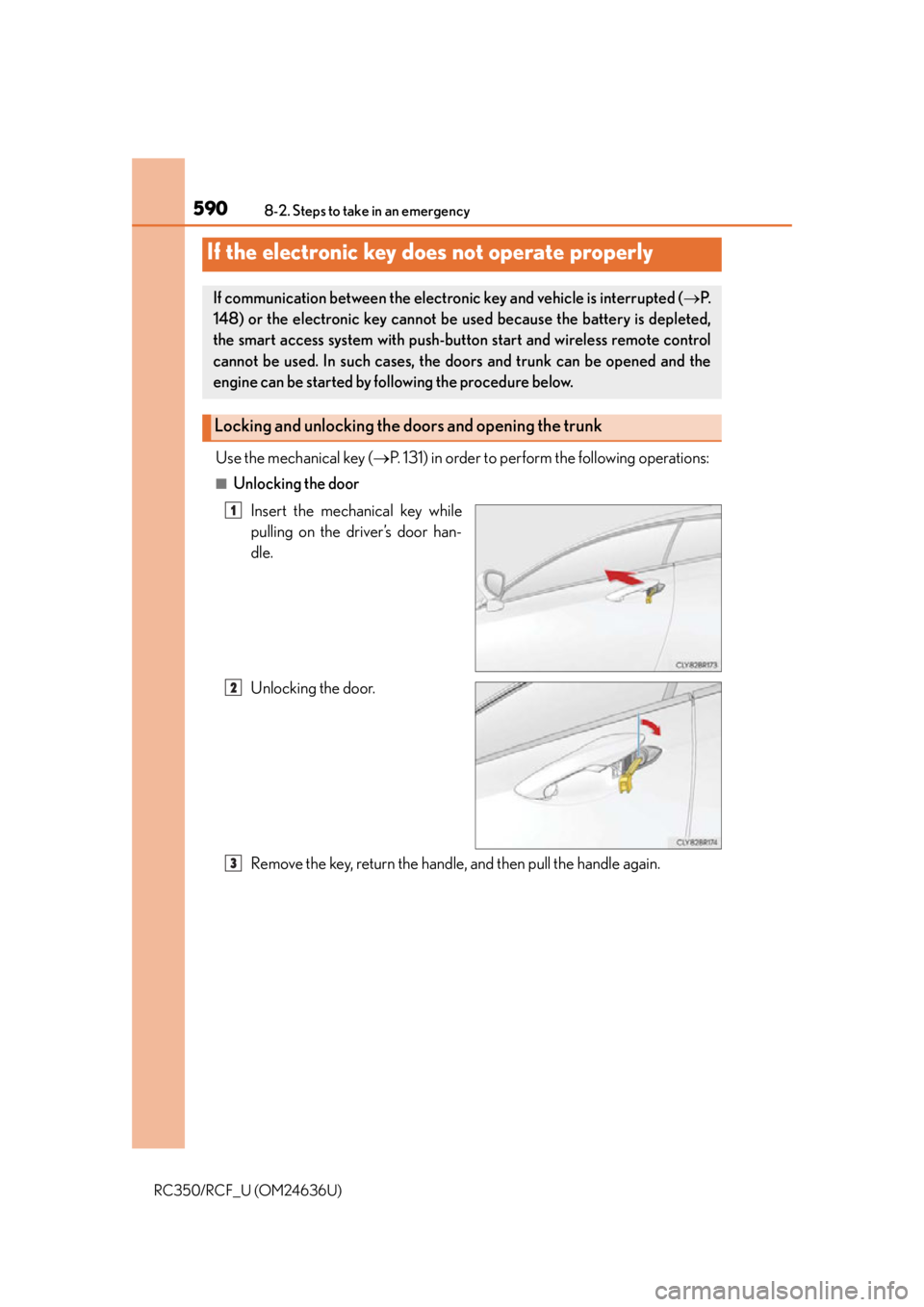
5908-2. Steps to take in an emergency
RC350/RCF_U (OM24636U)
Use the mechanical key (P. 131) in order to perform the following operations:
■Unlocking the door
Insert the mechanical key while
pulling on the driver’s door han-
dle.
Unlocking the door.
Remove the key, return the handle, and then pull the handle again.
If the electronic key does not operate properly
If communication between the electronic key and vehicle is interrupted ( P.
148) or the electronic key cannot be used because the battery is depleted,
the smart access system with push-button start and wireless remote control
cannot be used. In such cases, the doors and trunk can be opened and the
engine can be started by fo llowing the procedure below.
Locking and unlocking the doors and opening the trunk
1
2
3